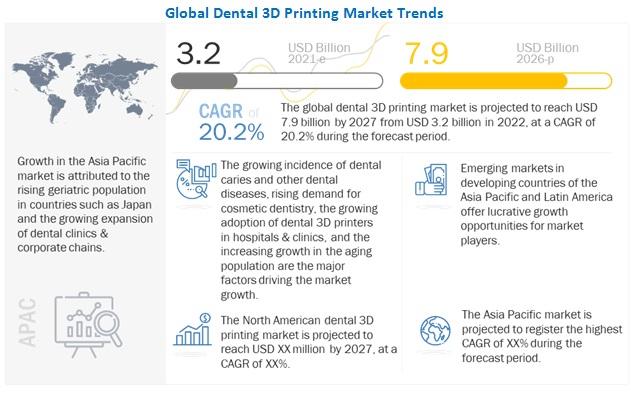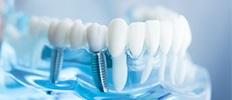According to a new research report "Dental 3D Printing Market by Product(Material (Plastic, Metal), Equipment(3D Scanner & Printer), Service), Technology (Vat Photopolymerization, FDM, SLS, Polyjet), Application(Prosthodontics, Implants), End-User(Labs, Hospitals) - Global Forecast to 2027" , the dental 3D printing is projected to reach USD 7.9 billion by 2027 from USD 3.2 billion in 2022, at a CAGR of 20.2%.
The increasing incidence of dental caries and other dental diseases, rising demand for cosmetic dentistry, the growing adoption of dental 3D printers in dental hospitals & clinics, and the increasing growth in the geriatric population. On the other hand, the rising number of large dental practices is expected to limit market growth to a certain extent.
In an optimistic scenario, the need for smoother clinical workflows, faster turnaround times, and fewer dental appointments could boost the market growth. Dentists may be more likely to invest in technologies like CAD/CAM and dental 3D printing to reduce the time taken to deliver dental appliances and treatment, and patients may be more likely to opt for these solutions for the same reason.

Dental caries or tooth decay is a common ailment across all age groups, with the global incidence of decayed and missing teeth (DMT) increasing dramatically in recent years. According to the CDC, in 2019, 64.9% of adults aged above 18 years of age had a dental examination or dental cleaning procedure. According to the American College of Prosthodontists, more than 36 million Americans are completely edentulous, and around 120 million Americans are missing at least one tooth.
The number of partially edentulous patients is expected to increase to more than 200 million Americans in the next 15 years. Single crowns to replace a missing tooth were the most common restorative procedure; according to the American College of Prosthodontists, ~2.3 million implant-supported crowns are made annually.
To know about the assumptions considered for the study, Request for Free Sample Report
The greatest advantages of dental 3D printing are the speed and accuracy offered by dental 3D printers. An increased level of automation ensures better overall accuracy and far less time consumed than manual model making. Multiple appliances can be printed simultaneously once the digital copy has been sent. This implies that the technician can begin working as soon as the copy of the scan arrives.
